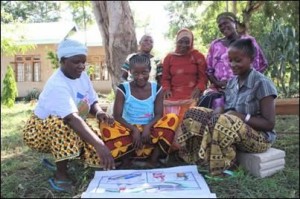Technology for Change: A Collaborative Effort
 If you examine any single health intervention, more often than not, there are multiple actors in play. Even if the intervention seems straightforward, there will inevitably be the need for a variety of sectors to become involved. With that in mind, public health has evolved in the past decade to include new collaborative business models that draw from the expertise from an array of sectors across a multitude of fields to utilize a more holistic approach to development. Now with the inclusion of various information and communication technologies (ICTs) in our interventions, the need for buy-in and partnerships between everyone from public health to technology to government to the private sector is even more crucial.
If you examine any single health intervention, more often than not, there are multiple actors in play. Even if the intervention seems straightforward, there will inevitably be the need for a variety of sectors to become involved. With that in mind, public health has evolved in the past decade to include new collaborative business models that draw from the expertise from an array of sectors across a multitude of fields to utilize a more holistic approach to development. Now with the inclusion of various information and communication technologies (ICTs) in our interventions, the need for buy-in and partnerships between everyone from public health to technology to government to the private sector is even more crucial.
The Health Communication Capacity Collaborative (HC3) hosted a workshop at the NetHope Global Member Summit in St. Charles, Illinois on October 14th. The NetHope Summit was a week-long event for its 39 member organizations and even longer list of supporters. NetHope members are diverse and include organizations such as CARE, Habitat for Humanity, OxFam, and PATH. They wok for a common cause: to leverage ICTs for development in fields such as emergency response, health, environmental sustainability, and education. The premise of NetHope is simple: to bring together the relevant actors and come up with solutions. At HC3’s workshop on Monday, the objective was to figure out how to move this collaborative spirit forward in health communication.
The workshop was attended by five organizations that work broadly in the field of development, both domestically and internationally. Although these groups did not necessarily have health communication activities on the forefront of their portfolios, they had a vested interest in bettering health outcomes and strengthening health systems using health communication as an indispensable tool. Their perspectives were varied: from different health focus areas, different regions in the world, and different capacities on the ground. The conversation began with setting a common language and talking about health and behavior change communication basics. Once the foundation was set, discussion shifted to figure out how to leverage all of the various experts and capacities in the room to find solutions to common problems.
Among the areas of focus for all of the organizations, maternal health seemed to be the underlying common thread. Also a proxy for the strength of health systems, maternal health outcomes are not only critical to bettering the lives of women worldwide, but also sound maternal health services require action from several sectors including: the government, drug distributors, service providers, and more. The organizations in attendance all agreed that there were several existing resources in maternal health. Certainly, toolkits have been made and many templates exist particularly for harnessing the potential of ICTs for maternal health. But there is a need for more knowledge management, and bringing all of these resources together so as not to “recreate the wheel.”
The attendees brought with them experience with various technological applications, such as reminder services, methods of teaching, and diagnostic tools. But by the end of the workshop, it was clear that those in attendance wanted to come together again, with even more actors around the table, to identify a common goal in health communication that technology could be used to achieve. In particular, discussions arose about developing a community monitoring approach that would span across sectors. This could allow better and more rapid evaluation of health indicators such as access to and quality of health services and begin to incorporate the voice of the community in the process.
HC3 is excited about the possibilities of these new partnerships. By organizing further workshops, HC3 is in the position to bring together seemingly dissimilar organizations for a common cause: using technology for health communication. Stay tuned for more on upcoming workshops, and next steps on these partnerships.






Leave a Reply
Want to join the discussion?Feel free to contribute!